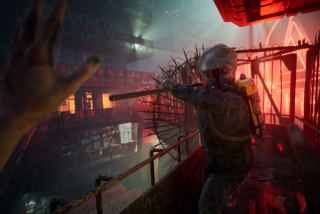Video Game Industry Split on Violence Issue
- Share via
For more than a decade, the computer game industry has struggled to shed its geek image and gain recognition as a legitimate entertainment business.
And just when it finally accomplishes that goal--hauling in $6.3 billion in revenue in 1998--it faces the much greater challenge of dealing with intense scrutiny over ties to recent violent acts in schools.
Game executives are divided over how to deal with this unwanted attention. Some software developers opt to ignore the issue altogether, while others are pushing to restore the industry’s image by boosting its presence in Washington and educating the public about its 5-year-old ratings system.
Behind this clash lurks a fundamental problem: Explaining itself to the general public is one game the industry hasn’t yet figured out how to play. Game executives are ambivalent about taking action but realize they must answer to critics or fall victim to government regulation.
“I’m frustrated that a lot of good entertainment will get overshadowed by this talk of violence,” said Patricia Becker, director of corporate communications for Electronic Arts, one of the oldest publishing houses in the video game business. “But we can’t ignore it any longer. If we do, we do so at our own peril.”
Nationwide hysteria over the rash of school violence reached new levels following the high school massacre in Littleton, Colo. Looking to find a reason for such horrific acts by America’s youth, parents, pundits and politicians turned to video games when it surfaced that the teen gunmen were fans of “Quake II” and “Doom,” a pair of hugely popular, ultraviolent titles created by Id Software.
Action was fast and furious. The political climate, already chilly toward video games, became frigid. Lawmakers seized the spotlight, calling for tightening restrictions on games and organizing summits on the culture of teen violence. Around the same time, the families of three girls killed in the 1997 school shooting in Paducah, Ky., filed a civil lawsuit against more than two dozen video game and entertainment companies.
For its part, the game industry’s immediate reaction was to run and hide instead of providing its side of the story.
“Our strategy is this: I keep my head down and program,” said John Carmack, Id Software’s co-founder and technical director.
Like many others in the industry, Carmack insists it’s not the responsibility of developers to become political lobbyists. Despite the enormous growth in revenue in recent years, most game developers run their companies like software start-ups, not huge corporations, said Carmack, whose company employs 15 and relies on fans to drive sales of its games and technology.
“We make the games we like to play and throw them out into the world,” said Carmack, a revered programmer with a tendency to shy away from contact with the media. “We don’t get involved in politics.”
So whose responsibility is it?
Neither the game makers nor their publishers have stepped up to the plate. Unlike the music and film industry, the video game business is relatively young. Because of that, the roles of the game creators and the corporate publishers are still being shaped, with neither taking a leadership position.
As a result, the industry’s trade group, the Interactive Digital Software Assn., has been pushed into being de facto cheerleader and defender. Yet when it kicked off last week’s Electronic Entertainment Expo, or E3, trade show in Los Angeles, the IDSA still seemed desperate to deflect the violence issue.
IDSA President Douglas Lowenstein pointed out positive aspects of the industry, noting the results of a national survey it conducted. “Americans rate games as the most fun form of entertainment,” Lowenstein said.
But much to their dismay, game makers at E3 couldn’t sidestep the violence and self-regulation issues. Vendors tried to stand in defiant unity, often chanting their mantra of innocence.
“Video games don’t kill kids, and video games didn’t put the guns into the hands of those kids,” said Karl Fitzhugh, an associate producer for the British game firm Bullfrog Productions Ltd., which makes educational games for young children.
Indeed, there is no evidence that playing video games leads to real-life violence. The most sweeping study on the issue, a 1996 report by Studio City-based think tank MediaScope, has been used by game critics and proponents alike to make their cases. The study itself had mixed results and concluded that extensive further research “must be considered before any conclusions are made.”
Carmack said he was “disgusted” by the notion that he or his staff would have to defend its games to Congress, the media or the general populace. After all, he said, Id Software isn’t making games for them.
The public scrutiny comes from people who don’t understand games, much less play them, say software developers. And that’s part of the problem. Fans insist they understand the subtle gradations of video game violence. But for a novice, there’s little distinction between a game in which people shoot monsters and another in which they run over pedestrians.
Even those in the industry acknowledge difficulties in trying to devise a one-size-fits-all scale of acceptable violence.
In 1994, the nation’s largest video game makers introduced a ratings system designed to help consumers understand the content of the product they were buying. Loosely modeled after the film industry’s ratings system, the video game system divided software into five categories ranging from titles for “early childhood” to content suitable for “adults only.”
The move enabled the industry to maintain its credibility with parents, by presenting a responsible public image while heading off federal intervention.
But as with the film industry ratings, enforcement falls into the hands of retailers who are often unwilling or unable to demand proof of age with purchase, said IDSA officials. It’s parents who most often buy games for their children, without understanding the ratings or the content of the software they have purchased.
In addition, the ratings system is broad, subjective and often confusing even to buyers who understand the nature of the games.
“It’s the big companies with big budgets who publish the games that should speak out,” said Peter Main, Nintendo’s executive vice president of sales and marketing. “As our industry has become so large, we have become fair game for this kind of criticism. We are part of pop culture. This is no longer a niche product.”
The fighter game “Thrill Kill,” for instance, garnered a huge following because of its extreme levels of gore and sexual content--even though it was never released. Last year, game makers nominated it for most popular title at E3. Despite the potential to make millions of dollars, Electronic Arts decided “Thrill Kill” was too gruesome and refused to sell it.
Game publishers insist they will do a better job of educating the public so parents will know their kids are playing “age-appropriate” games. Publishers also admitted they need to promote their ratings system.
Amid such promises, IDSA’s Lowenstein wasn’t able to lay a plan as to how the industry would achieve such goals or ensure that the ratings system is enforced by retailers.
In the meantime, the industry may be forced to act. Lawsuits seeking to hold entertainment producers liable for the content in films and games are increasing. And courts are becoming more amenable to these claims.
In March, the U.S. Supreme Court refused to block a lawsuit that seeks to hold filmmaker Oliver Stone liable for a young couple’s 1995 murderous rampage in Louisiana and Mississippi. The suit, filed on behalf of one victim’s family, claims that Stone’s 1994 movie “Natural Born Killers” was intended to incite others to violence.
The U.S. Senate last week voted to launch a National Institutes of Health study on the effects of violent video games. And several states are debating legislation to regulate or ban video game content.
What everyone can agree on is that the controversy surrounding violence in video games is unlikely to die soon, no matter how game makers respond.
“People are not wanting to talk about this, and that’s more disturbing than the questions that are being raised,” said L. Gregory Ballard, president and chief executive of 3Dfx Interactive, a San Jose graphics chip manufacturer. “There are some grave moral issues here that need to be dealt with, and the last thing we want is to get the government involved.”
P.J. Huffstutter can be reached at P.J.Huffstutter@latimes.com. Jennifer Oldham can be reached via e-mail at Jennifer.Oldham@latimes.com.






